Yifan Xie
Universal Visuo-Tactile Video Understanding for Embodied Interaction
May 28, 2025Abstract:Tactile perception is essential for embodied agents to understand physical attributes of objects that cannot be determined through visual inspection alone. While existing approaches have made progress in visual and language modalities for physical understanding, they fail to effectively incorporate tactile information that provides crucial haptic feedback for real-world interaction. In this paper, we present VTV-LLM, the first multi-modal large language model for universal Visuo-Tactile Video (VTV) understanding that bridges the gap between tactile perception and natural language. To address the challenges of cross-sensor and cross-modal integration, we contribute VTV150K, a comprehensive dataset comprising 150,000 video frames from 100 diverse objects captured across three different tactile sensors (GelSight Mini, DIGIT, and Tac3D), annotated with four fundamental tactile attributes (hardness, protrusion, elasticity, and friction). We develop a novel three-stage training paradigm that includes VTV enhancement for robust visuo-tactile representation, VTV-text alignment for cross-modal correspondence, and text prompt finetuning for natural language generation. Our framework enables sophisticated tactile reasoning capabilities including feature assessment, comparative analysis, scenario-based decision making and so on. Experimental evaluations demonstrate that VTV-LLM achieves superior performance in tactile video understanding tasks, establishing a foundation for more intuitive human-machine interaction in tactile domains.
Matching Distance and Geometric Distribution Aided Learning Multiview Point Cloud Registration
May 06, 2025



Abstract:Multiview point cloud registration plays a crucial role in robotics, automation, and computer vision fields. This paper concentrates on pose graph construction and motion synchronization within multiview registration. Previous methods for pose graph construction often pruned fully connected graphs or constructed sparse graph using global feature aggregated from local descriptors, which may not consistently yield reliable results. To identify dependable pairs for pose graph construction, we design a network model that extracts information from the matching distance between point cloud pairs. For motion synchronization, we propose another neural network model to calculate the absolute pose in a data-driven manner, rather than optimizing inaccurate handcrafted loss functions. Our model takes into account geometric distribution information and employs a modified attention mechanism to facilitate flexible and reliable feature interaction. Experimental results on diverse indoor and outdoor datasets confirm the effectiveness and generalizability of our approach. The source code is available at https://github.com/Shi-Qi-Li/MDGD.
MuseFace: Text-driven Face Editing via Diffusion-based Mask Generation Approach
Mar 31, 2025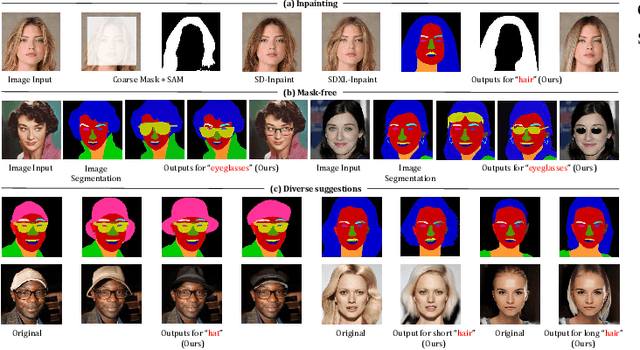
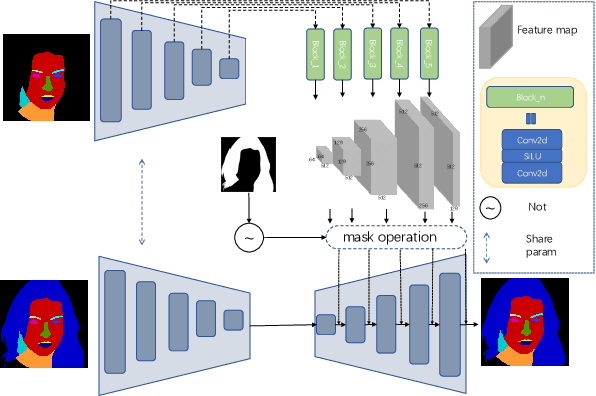
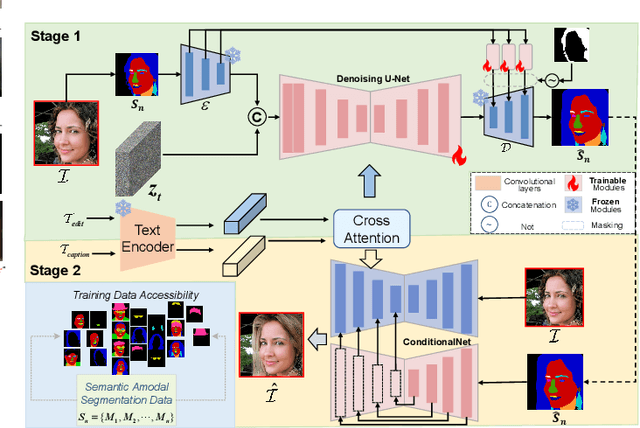
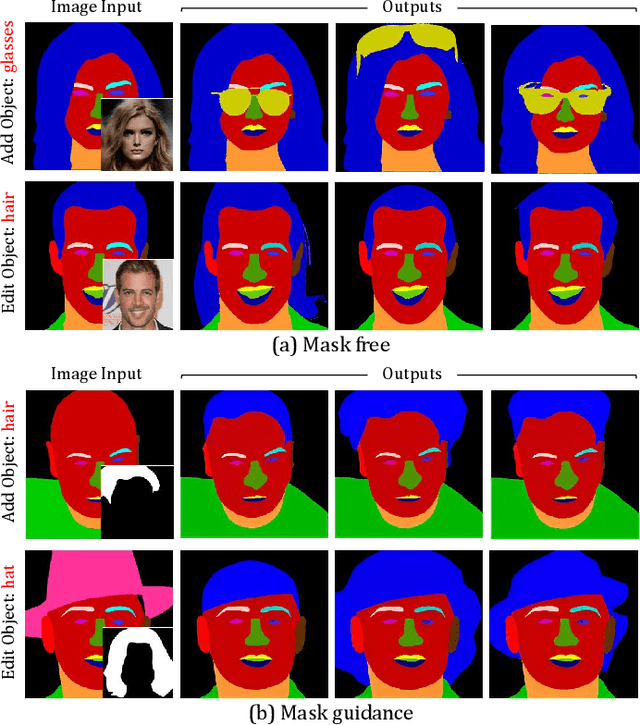
Abstract:Face editing modifies the appearance of face, which plays a key role in customization and enhancement of personal images. Although much work have achieved remarkable success in text-driven face editing, they still face significant challenges as none of them simultaneously fulfill the characteristics of diversity, controllability and flexibility. To address this challenge, we propose MuseFace, a text-driven face editing framework, which relies solely on text prompt to enable face editing. Specifically, MuseFace integrates a Text-to-Mask diffusion model and a semantic-aware face editing model, capable of directly generating fine-grained semantic masks from text and performing face editing. The Text-to-Mask diffusion model provides \textit{diversity} and \textit{flexibility} to the framework, while the semantic-aware face editing model ensures \textit{controllability} of the framework. Our framework can create fine-grained semantic masks, making precise face editing possible, and significantly enhancing the controllability and flexibility of face editing models. Extensive experiments demonstrate that MuseFace achieves superior high-fidelity performance.
Object Isolated Attention for Consistent Story Visualization
Mar 30, 2025Abstract:Open-ended story visualization is a challenging task that involves generating coherent image sequences from a given storyline. One of the main difficulties is maintaining character consistency while creating natural and contextually fitting scenes--an area where many existing methods struggle. In this paper, we propose an enhanced Transformer module that uses separate self attention and cross attention mechanisms, leveraging prior knowledge from pre-trained diffusion models to ensure logical scene creation. The isolated self attention mechanism improves character consistency by refining attention maps to reduce focus on irrelevant areas and highlight key features of the same character. Meanwhile, the isolated cross attention mechanism independently processes each character's features, avoiding feature fusion and further strengthening consistency. Notably, our method is training-free, allowing the continuous generation of new characters and storylines without re-tuning. Both qualitative and quantitative evaluations show that our approach outperforms current methods, demonstrating its effectiveness.
UniSync: A Unified Framework for Audio-Visual Synchronization
Mar 20, 2025Abstract:Precise audio-visual synchronization in speech videos is crucial for content quality and viewer comprehension. Existing methods have made significant strides in addressing this challenge through rule-based approaches and end-to-end learning techniques. However, these methods often rely on limited audio-visual representations and suboptimal learning strategies, potentially constraining their effectiveness in more complex scenarios. To address these limitations, we present UniSync, a novel approach for evaluating audio-visual synchronization using embedding similarities. UniSync offers broad compatibility with various audio representations (e.g., Mel spectrograms, HuBERT) and visual representations (e.g., RGB images, face parsing maps, facial landmarks, 3DMM), effectively handling their significant dimensional differences. We enhance the contrastive learning framework with a margin-based loss component and cross-speaker unsynchronized pairs, improving discriminative capabilities. UniSync outperforms existing methods on standard datasets and demonstrates versatility across diverse audio-visual representations. Its integration into talking face generation frameworks enhances synchronization quality in both natural and AI-generated content.
Observation-Graph Interaction and Key-Detail Guidance for Vision and Language Navigation
Mar 14, 2025Abstract:Vision and Language Navigation (VLN) requires an agent to navigate through environments following natural language instructions. However, existing methods often struggle with effectively integrating visual observations and instruction details during navigation, leading to suboptimal path planning and limited success rates. In this paper, we propose OIKG (Observation-graph Interaction and Key-detail Guidance), a novel framework that addresses these limitations through two key components: (1) an observation-graph interaction module that decouples angular and visual information while strengthening edge representations in the navigation space, and (2) a key-detail guidance module that dynamically extracts and utilizes fine-grained location and object information from instructions. By enabling more precise cross-modal alignment and dynamic instruction interpretation, our approach significantly improves the agent's ability to follow complex navigation instructions. Extensive experiments on the R2R and RxR datasets demonstrate that OIKG achieves state-of-the-art performance across multiple evaluation metrics, validating the effectiveness of our method in enhancing navigation precision through better observation-instruction alignment.
Unseen Horizons: Unveiling the Real Capability of LLM Code Generation Beyond the Familiar
Dec 11, 2024Abstract:Recently, large language models (LLMs) have shown strong potential in code generation tasks. However, there are still gaps before they can be fully applied in actual software development processes. Accurately assessing the code generation capabilities of large language models has become an important basis for evaluating and improving the models. Some existing works have constructed datasets to evaluate the capabilities of these models. However, the current evaluation process may encounter the illusion of "Specialist in Familiarity", primarily due to three gaps: the exposure of target code, case timeliness, and dependency availability. The fundamental reason for these gaps is that the code in current datasets may have been extensively exposed and exercised during the training phase, and due to the continuous training and development of LLM, their timeliness has been severely compromised. The key to solve the problem is to, as much as possible, evaluate the LLMs using code that they have not encountered before. Thus, the fundamental idea in this paper is to draw on the concept of code obfuscation, changing code at different levels while ensuring the functionality and output. To this end, we build a code-obfuscation based benchmark OBFUSEVAL. We first collect 1,354 raw cases from five real-world projects, including function description and code. Then we use three-level strategy (symbol, structure and semantic) to obfuscate descriptions, code and context dependencies. We evaluate four LLMs on OBFU- SEVAL and compared the effectiveness of different obfuscation strategy. We use official test suites of these projects to evaluate the generated code. The results show that after obfuscation, the average decrease ratio of test pass rate can up to 62.5%.
PointTalk: Audio-Driven Dynamic Lip Point Cloud for 3D Gaussian-based Talking Head Synthesis
Dec 11, 2024



Abstract:Talking head synthesis with arbitrary speech audio is a crucial challenge in the field of digital humans. Recently, methods based on radiance fields have received increasing attention due to their ability to synthesize high-fidelity and identity-consistent talking heads from just a few minutes of training video. However, due to the limited scale of the training data, these methods often exhibit poor performance in audio-lip synchronization and visual quality. In this paper, we propose a novel 3D Gaussian-based method called PointTalk, which constructs a static 3D Gaussian field of the head and deforms it in sync with the audio. It also incorporates an audio-driven dynamic lip point cloud as a critical component of the conditional information, thereby facilitating the effective synthesis of talking heads. Specifically, the initial step involves generating the corresponding lip point cloud from the audio signal and capturing its topological structure. The design of the dynamic difference encoder aims to capture the subtle nuances inherent in dynamic lip movements more effectively. Furthermore, we integrate the audio-point enhancement module, which not only ensures the synchronization of the audio signal with the corresponding lip point cloud within the feature space, but also facilitates a deeper understanding of the interrelations among cross-modal conditional features. Extensive experiments demonstrate that our method achieves superior high-fidelity and audio-lip synchronization in talking head synthesis compared to previous methods.
A Review of Human Emotion Synthesis Based on Generative Technology
Dec 10, 2024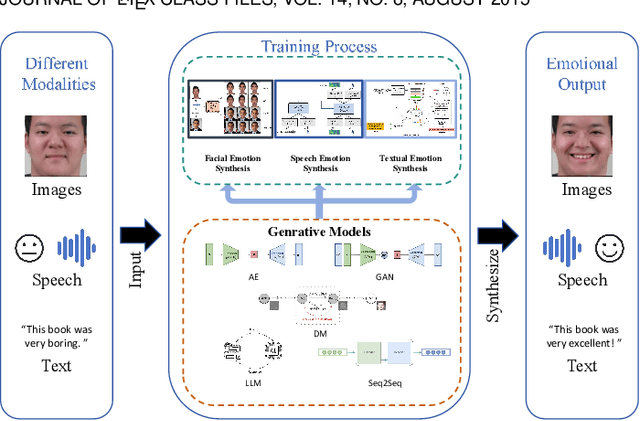
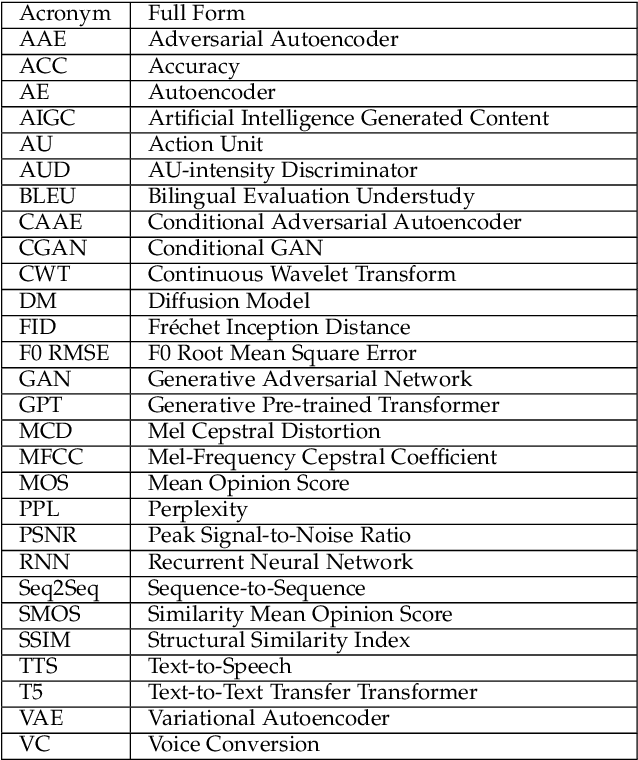
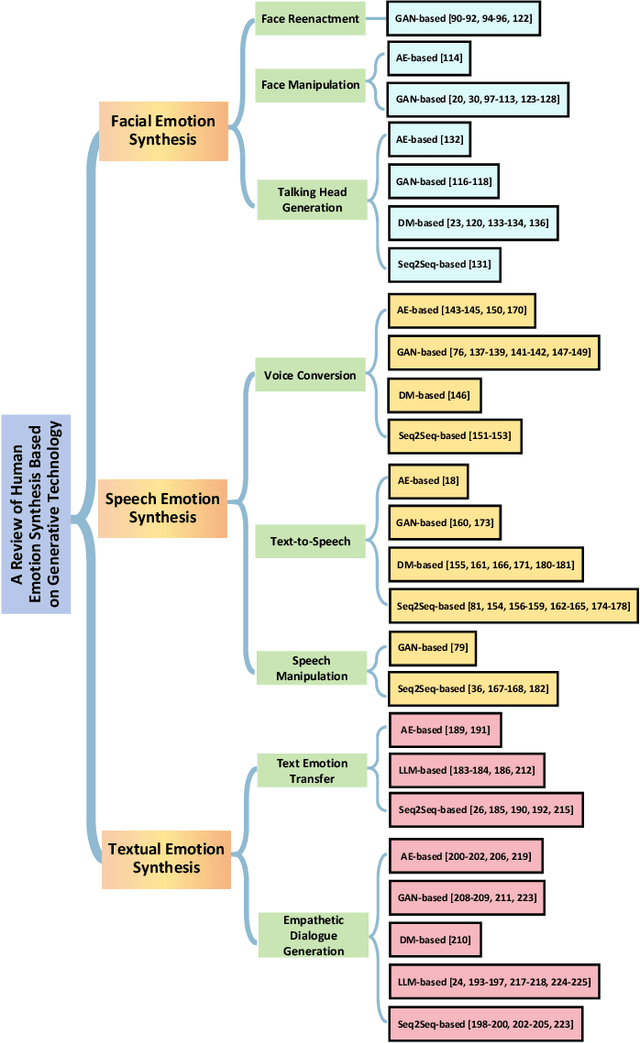

Abstract:Human emotion synthesis is a crucial aspect of affective computing. It involves using computational methods to mimic and convey human emotions through various modalities, with the goal of enabling more natural and effective human-computer interactions. Recent advancements in generative models, such as Autoencoders, Generative Adversarial Networks, Diffusion Models, Large Language Models, and Sequence-to-Sequence Models, have significantly contributed to the development of this field. However, there is a notable lack of comprehensive reviews in this field. To address this problem, this paper aims to address this gap by providing a thorough and systematic overview of recent advancements in human emotion synthesis based on generative models. Specifically, this review will first present the review methodology, the emotion models involved, the mathematical principles of generative models, and the datasets used. Then, the review covers the application of different generative models to emotion synthesis based on a variety of modalities, including facial images, speech, and text. It also examines mainstream evaluation metrics. Additionally, the review presents some major findings and suggests future research directions, providing a comprehensive understanding of the role of generative technology in the nuanced domain of emotion synthesis.
CCIS-Diff: A Generative Model with Stable Diffusion Prior for Controlled Colonoscopy Image Synthesis
Nov 19, 2024



Abstract:Colonoscopy is crucial for identifying adenomatous polyps and preventing colorectal cancer. However, developing robust models for polyp detection is challenging by the limited size and accessibility of existing colonoscopy datasets. While previous efforts have attempted to synthesize colonoscopy images, current methods suffer from instability and insufficient data diversity. Moreover, these approaches lack precise control over the generation process, resulting in images that fail to meet clinical quality standards. To address these challenges, we propose CCIS-DIFF, a Controlled generative model for high-quality Colonoscopy Image Synthesis based on a Diffusion architecture. Our method offers precise control over both the spatial attributes (polyp location and shape) and clinical characteristics of polyps that align with clinical descriptions. Specifically, we introduce a blur mask weighting strategy to seamlessly blend synthesized polyps with the colonic mucosa, and a text-aware attention mechanism to guide the generated images to reflect clinical characteristics. Notably, to achieve this, we construct a new multi-modal colonoscopy dataset that integrates images, mask annotations, and corresponding clinical text descriptions. Experimental results demonstrate that our method generates high-quality, diverse colonoscopy images with fine control over both spatial constraints and clinical consistency, offering valuable support for downstream segmentation and diagnostic tasks.
 Add to Chrome
Add to Chrome Add to Firefox
Add to Firefox Add to Edge
Add to Edge